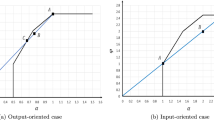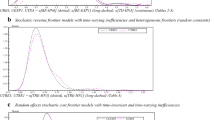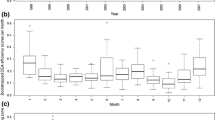Abstract
The purpose of this study was to analyse the technical efficiency, meta-frontier, and technological gap ratios of six world fishery regions during the years 1960–2010. We calculated the efficiency level for Europe, Asia, North and Central America, Africa, South America, and Oceania, based on countries from which adequate data were available. While world fish stocks are suffering from overexploitation, and many countries have initiated stock rebuilding plans to overcome this issue, we offer a new solution. Although many country’s efficiency levels are high within their region, on a global scale, few can be considered efficient. This shows that today’s worldwide fishery is facing a lack of cooperation. We hope that by showing the efficiency levels, countries can moderate the over-capacity, which imparts higher costs on the fishery sector, in addition to constrain most of the fisheries to harvest levels below regional maximum sustainable yield levels, while not reducing their economic return.





Similar content being viewed by others
References
FAO (2003) Review of state of world fishery resources: inland fisheries. FAO fisheries circular no 942, rev 1 FAO Rome, Italy, pp 60–62
FAO (2009) State of the world’s fisheries and aquaculture 2008. Food and Agriculture Organization of the United Nations, Rome
Pauly D, Christensen V, Guénette S, Pitcher TJ et al (2002) Towards sustainability in world fisheries. Nature 418:689–695
World Bank (2009) The sunken billions: the economic justification for fisheries reform. The International Bank for Reconstruction and Development/The World Bank, Washington, DC
Sumaila UR, Khan A, Watson R, Munro G et al (2007) The world trade organization and global fisheries sustainability. Fish Res 88:1–4
Anticamara JA, Watson R, Glechu A, Pauly D (2011) Global fishing effort (1950–2010): trends, gaps, and implications. Fish Res 107:131–136
Battese GE, Coelli TJ (1988) Prediction of firm-level technical efficiencies with a generalized frontier production function and panel data. J Econ 38:387–399
Glass JC, McKillop DG, Hyndman N (1995) Efficiency in the provision of university teaching and research: an empirical analysis of UK universities. J Appl Econom 10:61–72
Lovell CAK, Pastor JT (1997) Target setting: an application to a bank branch network. Eur J Oper Res 98:290–299
O’Donnell CJ, Van der Westhuizen G (2002) Regional comparisons of banking performance in South Africa. S Afr J Econ 70:485–518
Farrell MJ (1957) The measurement of productive efficiency. J R Stat Soc 120:253–281
Hayami Y, Ruttan VW (1971) Agricultural development: an international perspective. J Dev Econ 26:197–200
Charnes A, Cooper W, Rhodes E (1978) Measuring the efficiency of decision-making units. Eur J Oper Res 2:429–444
Rao DSP, O’Donnell CJ, Battese GE (2003) Metafrontier functions for the study of inter-regional productivity differences. J Product Anal 3:153–169
Assaf A, Barros CP, Josiassen A (2010) Hotel efficiency: a bootstrapped metafrontier approach. Int J Hosp Manag 29:468–475
Huang YJ, Chen KH, Yang CH (2010) Cost efficiency and optimal scale of electricity distribution firms in Taiwan: an application of metafrontier analysis. Energy Econ 32:15–23
Oh DH (2010) A metafrontier approach for measuring an environmentally sensitive productivity growth index. Energy Econ 32:146–157
FAO (2011) State of world fisheries and aquaculture. www.fao.org/docrep/013/i1820e/i1820e00.htm Accessed 17 Feb 2014
Battese GE, Rao DSP (2002) Technology gap, efficiency, and a stochastic Metafrontier function. Int J Bus Econ 1:87–93
Rao DSP, O’Donnell CJ, Battese GE (2008) Metafrontier frameworks for the study of firm-level efficiencies and technology ratios. Empir Econ 34:231–255
Nyemeck J, Nkamleu GB (2006) Potentiel de productivite et efficacite technique du secteur agricole en Afrique. Can J Agric Econ 54(2006):361–377
Coelli T (1996) A guide to DEAP v 2.1: a data envelopment analysis (computer) program. CEPA Working Group 96/09
Froese R, Pauly D (2003) Warnsignale aus Nordsee und Wattenmeer-eine aktuelle Umweltbilanz. In: JLozán JL, Rachor E, Reise K, Sündermann J, Westernhagen VH (ed) Warnsignale aus Nordsee und Wattenmeer—eine aktuelle Umweltbilanz, GEO, Hamburg
Author information
Authors and Affiliations
Corresponding author
Rights and permissions
About this article
Cite this article
Lee, SG., Rahimi Midani, A. Comparison of efficiency levels using meta-frontier analysis of global fisheries for the period 1960–2010. Fish Sci 81, 247–254 (2015). https://doi.org/10.1007/s12562-014-0839-2
Received:
Accepted:
Published:
Issue Date:
DOI: https://doi.org/10.1007/s12562-014-0839-2




